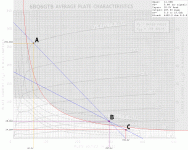I have built 2 amplifiers so far, both with single-ended output transformers. For my next design I want to try push-pull. I have my loadline, but I am at a loss how to calculate the expected power output. The formula I have been using is Vpk * Ipk * 0.5. Do I calculate power from A to B then B to C and add them?
Also, I know how to calculate plate dissipation with zero signal. How do you calculate plate dissipation with max signal for both single-ended and push-pull?
Also, I know how to calculate plate dissipation with zero signal. How do you calculate plate dissipation with max signal for both single-ended and push-pull?
Attachments
Assuming you are using class A push pull, the power output is twice the power single tube. This is because the voltage swing is twice working in a also twice output impedance. Normally, you can increase small percentage, because the PP cancel out 2nd and all even harmonics generated inside the stage, and, for a given THD, the power can be increased.
Keep in mind, that, the primary of the transformer IS DIFFERENT for a push pull class A amplifier, it must have 1/4 of the turns calculated for a single tube stage, because of the autotransformer reaction from one tube to the other.
Keep in mind, that, the primary of the transformer IS DIFFERENT for a push pull class A amplifier, it must have 1/4 of the turns calculated for a single tube stage, because of the autotransformer reaction from one tube to the other.
- Status
- Not open for further replies.
